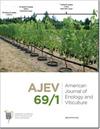Remote Sensing, Yield, Physical Characteristics, and Fruit Composition Variability in Cabernet Sauvignon Vineyards
IF 1.8
3区 农林科学
Q3 BIOTECHNOLOGY & APPLIED MICROBIOLOGY
引用次数: 7
Abstract
Soil texture, topographical data, fruit zone light measurements, yield components, and fruit composition data were taken from 125 locations in each of four Vitis vinifera L. cv. Cabernet Sauvignon vineyards in the Lodi region of California during the 2017, 2018, and 2019 seasons. Data were compared against three sources of normalized difference vegetation index (NDVI) with different spatial resolutions: Landsat 8 (LS8NDVI; 30 m), Sentinel-2 (S2NDVI; 10 m), and manned aircraft (at high resolution, HR) with the interrow removed (HRNDVI; 20 cm). The manned aircraft also captured canopy temperature (CT) derived from infrared (thermal) wavelengths (HRCT; 40 cm) for additional comparisons. HRNDVI was inversely related to HRCT, as well as to several chemical components of fruit composition including tannins and anthocyanins. While some constituents of fruit composition such as anthocyanins may be related to NDVI, canopy temperature, and/or indirect measurements collected in the field, results presented here suggest that yield and fruit composition have a strong seasonal response and therefore environmental conditions should be considered if more accurate predictions are desired. Furthermore, freely available public satellite data sources with mixed canopy and interrow pixels, such as Sentinel-2 and Landsat 8, provided similar information related to predicting specific fruit composition parameters compared to higher resolution imagery from contracted manned aircraft, from which the interrow signal was removed. Growers and wineries interested in predicting fruit composition that accounts for spatial variability may be able to conserve resources by using publicly available imagery sources and small numbers of targeted samples to achieve this goal.赤霞珠葡萄园的遥感、产量、物理特性和果实成分变异
在4个葡萄品种的125个地点分别采集了土壤质地、地形数据、果区光照测量、产量组成和果实成分数据。2017年、2018年和2019年季节,加州洛迪地区的赤霞珠葡萄园。将数据与三个不同空间分辨率的归一化植被指数(NDVI)来源进行比较:Landsat 8 (LS8NDVI);30 m), Sentinel-2 (S2NDVI;10 m),以及有人驾驶飞机(高分辨率,HR) (HRNDVI;20厘米)。有人驾驶飞机也捕获了来自红外(热)波长(HRCT)的冠层温度(CT);40厘米)进行额外的比较。HRNDVI与HRCT、单宁、花青素等果实化学成分呈负相关。虽然果实成分的某些成分如花青素可能与NDVI、冠层温度和/或田间收集的间接测量值有关,但本文的研究结果表明,产量和果实成分具有强烈的季节响应,因此如果想要更准确地预测,应考虑环境条件。此外,免费提供的公共卫星数据源,如Sentinel-2和Landsat 8,在预测特定水果成分参数方面提供了类似的信息,相比之下,来自合同载人飞机的高分辨率图像(其中去除了行间信号)提供了类似的信息。种植者和酿酒厂对预测水果成分的空间变异性感兴趣,可以通过使用公开可用的图像来源和少量目标样本来实现这一目标,从而节省资源。
本文章由计算机程序翻译,如有差异,请以英文原文为准。
求助全文
约1分钟内获得全文
求助全文
来源期刊

American Journal of Enology and Viticulture
农林科学-生物工程与应用微生物
CiteScore
3.80
自引率
10.50%
发文量
27
审稿时长
12-24 weeks
期刊介绍:
The American Journal of Enology and Viticulture (AJEV), published quarterly, is an official journal of the American Society for Enology and Viticulture (ASEV) and is the premier journal in the English language dedicated to scientific research on winemaking and grapegrowing. AJEV publishes full-length research papers, literature reviews, research notes, and technical briefs on various aspects of enology and viticulture, including wine chemistry, sensory science, process engineering, wine quality assessments, microbiology, methods development, plant pathogenesis, diseases and pests of grape, rootstock and clonal evaluation, effect of field practices, and grape genetics and breeding. All papers are peer reviewed, and authorship of papers is not limited to members of ASEV. The science editor, along with the viticulture, enology, and associate editors, are drawn from academic and research institutions worldwide and guide the content of the Journal.
 求助内容:
求助内容: 应助结果提醒方式:
应助结果提醒方式:


